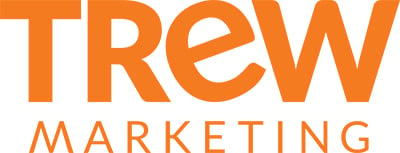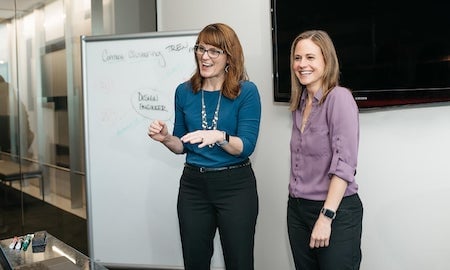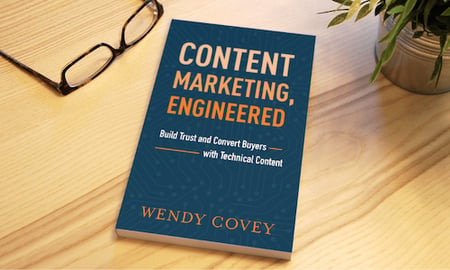Learn how to take a strategic and proactive approach to content planning.
Jennifer Dawkins, Vice President of Account Services at TREW Marketing, is an expert in content planning for both start-ups and enterprise companies. When it comes to the latter, she's seen her share of Content Managers who are overwhelmed with requests and have no formal process for planning and prioritizing content projects. This leads to random acts of content, lack of insight into performance, and a ton of aging content which can be detrimental to the brand.
During the episode, Jennifer shares key steps in developing a content plan. It starts well before the first content brainstorming session, as all content should tie back to a campaign with identified personas and success metrics. She walks us through how to conduct a content brainstorming session using a content topic cluster framework, and shares who should (and should not) be in the room.
We also cover accountability, measurement, how to handle ad-hoc content requests, and an approach to auditing aged content.
Resources
- Jennifer on LinkedIn
- Ansys case study: Focusing on Content Strategy to Optimize Content Creation
- eBook: Getting Started with Content Marketing - Year One
Transcript:
As companies grow in size, they also grow in complexity. And managing the matrix of content marketing needs can be challenging, to say the very least. But don't worry, help is here. Today I'm joined by a guest who will share her experiences of how to successfully approach content strategy and content prioritization. Let's do this.
Welcome to Content Marketing Engineered, your source for building trust and generating demand with technical content. Here is your host, Wendy Kobe.
Hi and welcome to Content Marketing Engineered. On each episode, I'll break down an industry trend, challenge or best practice in reaching technical audiences. You'll meet colleagues, friends, and clients of mine who will stop by to share their stories. And I hope that you leave each episode feeling inspired and ready to take action. Before we jump in, I'd like to give a brief shout out to my agency, TREW Marketing. TREW is a full service agency located in beautiful Austin, Texas, serving highly technical company. For more information, visit trewmarketing.com. And now on with our podcast.
Hey everyone, and welcome to another episode of Content Marketing, Engineered. Today I'm joined by Jennifer Dawkins. She's a vice president of account services at our own TREW Marketing. Welcome to the show, Jen.
Hi, Wendy.
I can't believe it's taken this long to have you on. It's about darn time.
It is.
Well, this is a great topic to focus on because I know it's one of your areas of deep expertise. So I'm very excited. Today we'll be covering how to take a strategic and proactive approach to content management. Before we get started, I think it will be helpful. Let's give some context to our listeners. And why don't you walk me through just a brief overview of your career journey?
Sure. So I started my career as a writer at National Instruments, a test measurement company here in Austin. Then I went on to manage their content team for about ten years. And then from there I worked in regional marketing and corporate marketing. And then about six years ago I joined TREW, and now I work with all kinds of companies, creating content plans and marketing plans and helping execute those plans.
So you really run the spectrum of small businesses, large businesses. How does it differ between the two when it comes to content planning?
Yeah. So the main difference between creating content plans for a small company and a large company is the structure of the companies are obviously quite different, and the complexity of the plans are pretty different. So with big companies, there are multiple teams involved. There's maybe a corporate team and a product team and a regional team, multiple campaigns that you're combining versus with a small company. You're typically creating content plans for either a single product or maybe the whole company. Everyone you need is in the room. They maybe don't even have a marketing team or they have three people on the team. So definitely a little bit different.
Which is harder and which is more fun?
I would say gosh, it so depends. Definitely harder is the bigger. There's just more things and more people to coordinate, more complexity. They're both fun.
Good. Well, for today's episode, we want to focus on the larger end of the spectrum. So in my mind, I'm picking Fortune 500 sized companies. And so for them, what are just some common challenges that come up over and over again with content management.
Yeah, so the biggest challenge stems from that multiple teams. It's kind of this distributed ownership of there's not one owner of content. So there's different groups have to work together and there are different audiences and different campaigns that you kind of all have to put together. So I think that's the biggest challenge. Another challenge is somewhat surprising, and that is metrics tracking. So you would think that a bigger company that has all the fancy tools and has multiple teams and lots of people, people sometimes devote adjusted tracking metrics. You would think they would have all the metrics.
Yeah.
But those companies are often the ones that don't really have a good idea of how their content is performing, because the person creating the content might not be the same, definitely isn't the same person pulling the metrics, but might not even know about those metrics. Or there could be different metrics. There could be one team that's creating Legion or pulling the Legion metrics versus another team that's web. And so there is actually oftentimes less insight into how content is doing and less data driven decisions with the bigger companies, which actually seems surprising, but it is TREW a lot.
Yeah. And I guess thinking back to my own days, I see what you mean. Because each group is responsible for their piece of the funnel or their channel, and content, of course, spans everything. It is definitely a different lens. And then, of course, you have systems that don't talk to each other. Just another frustrating thing. Well, let's see if we can't fix some of these challenges or at least provide some workarounds. I don't know where we'll go with this. And just start with what are some of the key steps to building a plan? Like, where do you start? Surely you have some strategy. That's the thing you do before you jump into writing, right?
Absolutely. So all content should roll up and support a bigger overarching campaign plan, business unit plan, marketing plan. So instead of talking about where to start a content plan, I would talk about a prerequisite to that. And that is making sure you have a really solid campaign plan, for instance, so you know where you're focusing, who your target audience is, what they care about, what their pain points are, what are some of the key applications that you're focusing on? Having your messaging down, that is really the first step to content planning. And it's before content planning even starts. So that's definitely where companies start.
Okay? So they need to have campaigns in place. Campaigns have goals. Campaigns need a lot of content to support them. Is there such a thing as too much content?
I get asked this question a lot. Objectively, there is too much content. I've worked with companies that have created literally hundreds of webinars in a single quarter, say, or you go to the resource section and there are thousands of white papers that they're expecting visitors to sift through. So yes, that is too much content. But far more often too much content or what is too much is determined by the actual team. So when I start working with a company and they say, oh, we don't have time to track it, we create all this stuff, there's no way we could track all those metrics. Or if someone says, yeah, we create a ton of content but we don't have time to go back and keep the stuff on our website updated, those are signs that you have too much content. So most of the time the amount of content that is too much is when you kind of cross that threshold of what you can manage. So what you can effectively create and make sure that it's really good content, what you can manage after it's created, what you can track. So by not doing those and spending the time instead just to crank out more content is actually going to hurt you more than just creating less content, but doing it really well and really strategically.
Yeah, that makes sense. And I think about how sometimes it's the older content that performs well on search. And so if you're not managing that old stuff and you're just creating new stuff, but people are keep finding the old stuff, you have a problem. But I have a feeling we'll get the lifecycle management. So I'm jumping ahead. Okay, so campaigns are established, we have goals. Now I'm guessing it's time to hold some planning meetings. So what do those look like?
So the first key to successful planning meetings is making sure that you have the right people in the room. And so there's no like, these are the five people you have to have formula. But in general, obviously the campaign manager should be there that has a holistic view across the campaign. Somebody from either sales or maybe a customer service team, somebody that interacts regularly with actual customers, knows what they care about, knows the questions they ask, the objections they have. That's going to be really important. Somebody from your technical team is good. So maybe someone from RND or maybe someone from technical marketing there to kind of supply more of the technical side on what you might be writing about and then an executive sponsor of some sort is really important. So the person that can make sure that once you create the plan, it can be resourced that has that influence to make decisions and kind of be your champion at the executive level. So those are at least a few of the key people that should be there.
And would it always be that executive is rolling up their sleeve in the planning process or are they more assigned to review it, champion it, approve it, or does it? Just depends.
It depends. Mostly they are involved. They will almost always have really good insight in the planning process and so it's not that they're kind of there just to make sure resourcing absolutely. Those people are really critical. They have just that bigger picture. So that is really important. But then absolutely having they might not actually review the content, they might not be involved in the development of it, but having them really understand and believe in it is going to be important to making sure things get done.
Yeah, that makes sense. Okay, I think I know the answer to this, but I'll ask it anyway. Can there be too many people involved in creating a plan?
Yeah, I've been in effective planning meetings with two people and I've been in effective planning meetings with ten people, which I would say probably would be too many, but it could be effective. I think the key sign that you've crossed over into too many people is when there are people in the room that are unengaged. So if you have eight people and three of them never speak, that might be because they're not the right person, but it is often because there's just too many voices in the room. So the key is to make sure everybody is actively engaged and actively participating.
That's good advice for any meeting anywhere.
Yes, that's right.
So I'm sitting there in the room, I want to be engaged. Describe a typical content brainstorming session. What does it look like?
So the way that we do content planning at TREW is we use a topic cluster approach to planning. And so essentially high level. What this is, is coming up with a few key themes. So these themes are things that your target audience cares about, you're an expert in, you have lots to say about it. So it could be autonomous vehicle lighting could be a theme or WiFi IoT solutions. So it needs to be decently, specific to what your customers care about, but broad enough to write several different things around it. So once you come up with your theme, then we brainstorm topics related to that theme. So for the WiFi IoT solutions, you might have subtopics, that could be application areas like Smart Retail or Smart Home. You could have technology focused topics. WiFi Six in the transition to new standards could be one. It could be regulations, considerations, low power security, things like that. So once you have those topics, we prioritize the top maybe six or eight depending on how much content you need, and then build those content topics out into actual content pieces. So what's the angle what are you going to say about low power?
What are you going to say? Is it design considerations? Is it high level or is it for your audience? And then once we have those angles, we decide what's the best form factor content type to tell that story. Is this best told through a visual graphic or is it a long form piece of content? Or is it a panel webinar maybe, or is it a case study? So that's kind of the crux of how we run those meetings.
What is the difference between having a core piece, like a long form article or white paper and something that's repurposed and when does repurposing enter into the picture?
So in the planning session, we definitely touch on that. So if there is a core piece and we know. Oh. So we're going to have this blog series and that could roll up and be an ebook and then that might kind of come up. There a lot of that planning for derivative content kind of comes after that planning session when you're building out that bigger plan and taking those ideas and creating a really tactical plan from them.
Okay, that makes sense. So when you're creating these topic clusters, when do you decide what target persona you are trying to reach? Or is the whole thing targeted at one persona? Or can there be one cluster for each persona or can several personas be serviced by one?
That's a great question. So it can be either one. We definitely want to talk about in the beginning when we're setting the stage. If your campaign is very targeted toward one persona overall, then obviously everything around it is going to be focused on that one persona. If you have multiple personas and when you first come up with your theme, that is an area where you can say, okay, is this theme something that all of the personas care about? Is it something that maybe the only low level engineers care about? Are there different aspects of that? So just before the topics even come up, that is something that is somewhat decided and discuss. So when we're thinking of that, we know if we decide it's multiple, when we're coming up with the angle, that's usually where we're like, okay, this can come, this is a very high level, this is people that care about this, or we need to make sure that we have coverage for each of the personas as well. So it's definitely touched on and discussed in the brainstorming meeting, but it's highly variable.
Well, I like that this is a flexible framework because as much as we would love everything to be neat and tidy and it's one persona and one thing in these topics and it's all neat and tidy, no, we know it's complex engineering solutions. Oftentimes you have these buying teams and different care about, but they're all tied together. So having that flexibility and really thinking it through seems like a very important aspect of the planning process.
Absolutely.
Okay, so let's fast forward in time we had our brainstorming sessions. You have all these notes. How do you translate that into a final plan? And is there other information that needs to be added or considered before you sign and seal it and go to the blessing part?
Absolutely, yes. The brainstorm informs what you're going to write, but that's just one piece. So from those brainstorming sessions, what we will typically do is take all of the content ideas that we came up with and map them to the buyer's funnel or the buyer's journey. So making sure that you have content pieces to bring people in at the awareness level to convert them, that you have sort of bottom of the funnel. So making sure that that is all covered and it's not just the new ideas that we thought of in that session that I take into consideration, it's any viable content that exists that is still good and current and it might be something that can be used as is, it might be something that needs to be updated. And then you had mentioned derivative content before. That's absolutely where you can take a really core media piece and then maybe create some high level awareness level pieces for that as well. So once I mapped out to the buyer's journey, I see are there holes, there could be additional conversations that need to happen and those holes need to be filled in. But once we ensure we have coverage across the buyer's journey, then there's things to take into consideration, like a product launch or an event that you need to have content for or any big things happening throughout the year that might affect timing of content or it might affect maybe you need some things before and then you need some things after.
So those definitely inform when we create things. And then I always want to think about what is the journey that we want people to go on. When somebody reads this piece, what is the next piece and what is the next piece and that will inform when you need to create things. So the anchor content that eventually everyone will go to needs to actually be created first, even though your visitor might see that awareness level piece first because you have to have where to link them to and where to link them to. So that also informs kind of how we put things on a calendar so those can help get your overall content plan plus out. And then a really important step is then taking your final content plan, combining that with other teams plans so that way you have a holistic view and you can make sure that okay. When we take my campaign and then these other three campaigns and put it all together, is it doable, do we have the resources to create all of these things? Are we planning too many things in one certain time frame.
Oh, I can't imagine that ever happened. What? Absolutely.
Or are we duplicating work? I mean, there could be a really great idea for a topic that was basically the same across a couple. So maybe you can get efficiencies. Yeah.
Okay, so now that this ever happens jen ever. But let's just say a rogue product manager comes along and they ask for content. It's not during the planning season, it's not part of a campaign. And so as a content manager, what typically happens or what should happen in that moment?
Yeah, that's a good question. So any good plan definitely leaves room for opportunistic things to come up because things will come up. There could be a competitive threat. There could be a great news story that you have something that you can tack onto and say about that. It could be just a great idea nobody thought about during the planning process. So you don't want to kabosh I definitely recommend leaving a small percentage, maybe 10% or so of the overall content you want to create unallocated that you have resources for these ideas that come up. So then whenever someone comes to you and has this idea, you can hear them out and maybe it's great and it warrants being in that 10%. Maybe you didn't plan for that 10%, but the idea is so great that you want to swap it out with something you already have planned that can definitely happen. Or maybe it's a great idea, but just doesn't fit into what you have right now. And so it's something that you can put on the shelf and when you have your next round of planning, it's there and you have those ideas.
Okay, so plan with some flexibility. Business is not stagnant, so I like that, but have a criteria in the process, so be prepared right before that request comes with, what is my process for vetting this? How do I handle this? That's great. Okay, so once content is written and published, who's responsible for measuring performance metrics?
Yeah.
What do they measure?
Yeah. So let's actually step back a little bit. So before content is created, a piece of content is created. Maybe part of the campaign planning process or maybe just something that the corporate team does. Creating baselines for each piece of content is really important. So people creating the content should know what does good look like, what does that look like? So that's kind of the first set of metrics that I always recommend before you start creating content that you have a general idea for. If we have a webinar, we expect X number of registrants, and we know of those many people will attend. Or if we do a case study, we expect to see X number of views on that case study. So once you have those in place, then whenever you create a piece of content, whoever's going back and looking at the metrics can tell is this unusually high or low and why? So who does that? Varies. It's great if it is the content owner, the person creating it because that helps kind of inform. They're the one with the most control. If they're creating content of what they can do differently it often just doesn't work out that's that person's job responsibility or that they have time for that.
So it could be someone that works in the campaign or the campaign manager. The biggest thing is whoever is doing it that it is communicated. So if a webinar does magically great or really bad that that is communicated and a discussion is had around that of okay, well why? Is it because of promotion or is it because of topic or do we have the wrong audience? And that is informed. And so that's my content piece. But then of course overall there are campaign metrics and a scorecard that content collectively is helping achieve those metrics and that's typically the campaign manager that is tracking and keeping track of those.
Got it. Okay, one final question. This has been great. I feel like for campaign or excuse me, content managers at large companies all this is such practical helpful advice. So I love getting in your head like this, but parting question, why Jen, is it so important to have a content strategy versus flying by the seat of your pants?
So I think we all know why content in general is important, right? It builds trust, gives you credibility, helps people find you, helps build your brand. So those are all the same reasons why it's important to do it really well. So if people find your content it's so important that that content is up to date, it reflects what you currently do. It shows you in a good light. So if every piece of content that you're creating is good as the next step, it's going to do so much more for you than if you're just putting pieces out there. Even if by just putting pieces out there you can do three X more, it actually can hurt you quite a bit. If the piece people are finding is not current. It doesn't look like you are speaking to your audience.
Okay, well, we're running out of time so I would love to invite you back. I feel like there's a whole nother episode just on content lifecycle management and I'd really like to dive into that because for larger companies that's a pretty big problem and it could be unwilling.
Absolutely.
So I guess without going too deep, just to teaser, how often do you do that and what are some just quick tips on lifecycle management?
Yeah, so I would actually say lifecycle management is just as important as new content creation. So it depends on what tools you have. If you have a digital asset management system or not, that kind of makes it a lot easier. But in general, putting some framework around. Each piece of content that we have out there is going to be looked at once a year, say, and that once a year is looking at it. Are there product mentions that are outdated? Is it getting any traffic at all? Is it even worth having it out there, or is it getting fantastic traffic from search? And we need to make sure that the next call to action is something good and relevant. So I'd say at least once a year, looking at every piece of content you have and making an evaluation of good as is needs to be updated or maybe just needs to go away. I think that's really important to do. No matter how you do it, there's multiple ways of kind of putting a process in place and some tools that help you automate that. And sometimes it's very manual. It can be an Excel spreadsheet.
Yes. We see everything, don't we?
Yeah.
Well, Jim, thank you so much for your time today. Where can people go to connect with you and learn more about content planning?
Sure. So you can connect with me on LinkedIn, Jennifer Dawkins, and then, of course, on our website, we have multiple blogs about content strategy, content planning, and we have an ebook, Content Planning Year One, that has some information on some of this as well.
Okay. And I know there's a great case study too, with a company you worked with, ancest on just the process of getting internal alignment and creating a framework for developing your content strategy. So I'll be sure to include that link in the show notes as well.
That's great.
Yeah. All right, thank you for your time today, Jen.
All right, thanks. Have a great day.
Thanks for joining me today on Content Marketing engineered for show notes, including links to resources. Visit TREWmarketing.
Compodcast.
While there, you can subscribe to our blog and our newsletter and order a copy of my book, Content Marketing Engineers. Also, I would love your reviews on this podcast. Please, when you get a chance, subscribe and leave me your review on your favorite podcast subscription platform. Thanks and have a great day. Bye.
Wendy Covey
 Wendy Covey is a CEO, a technical marketing leader, author of Content Marketing, Engineered, one of The Wall Street Journal’s 10 Most Innovative Entrepreneurs in America, and she holds a Texas fishing record. She resides in a small Hill Country town southwest of Austin, Texas, where she enjoys outdoor adventures with her family.
Wendy Covey is a CEO, a technical marketing leader, author of Content Marketing, Engineered, one of The Wall Street Journal’s 10 Most Innovative Entrepreneurs in America, and she holds a Texas fishing record. She resides in a small Hill Country town southwest of Austin, Texas, where she enjoys outdoor adventures with her family.
About TREW Marketing
TREW Marketing is a strategy-first content marketing agency serving B2B companies that target highly technical buyers. With deep experience in the design, embedded, measurement and automation, and software industries, TREW Marketing provides branding, marketing strategy, content development, and digital marketing services to help customers efficiently and effectively achieve business goals.






 Wendy Covey
Wendy Covey

